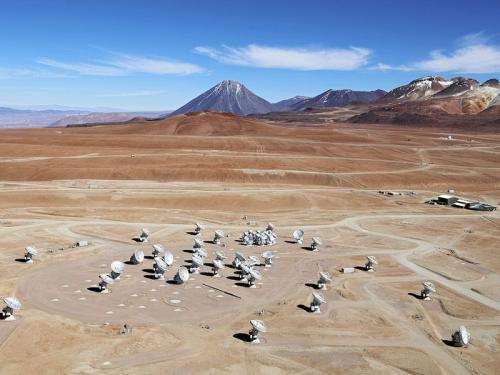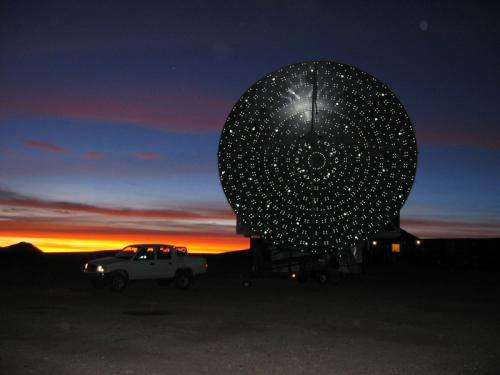Gazing into the frozen stillness of the universe

(Phys.org) —The ALMA telescope installation begins delivering images of fresh planets, young stars, and distant galaxies.
Astronomers have a new window on the universe: The ALMA telescope installation has now officially gone into operation. This array, known as the Atacama Large Millimeter/submillimeter Array, is located atop the Chilean Chajnantor Plateau and will comprise 66 antennas in its final construction configuration at the end of the year. Astronomers from the Max Planck Institute for Radio Astronomy are already working with this powerful instrument. And they had a large part in the development and construction of a prototype.
Up here at 5,100 m above sea level, the air is clear, cold, and dry. This last characteristic in particular makes the highlands of the Chilean Atacama Desert one of the best observational locations in the world. After all, terrestrial water vapour cannot be allowed to interfere with visibility in the quest to peer into the dusty, cool regions of the universe. Oxygen above all weakens the radio waves at the edge of infrared light and obscures the images of the cosmic worlds. The unspoiled view rewards the astronomers for the difficult life on the Chajnantor Plateau.
ALMA Director Thijs de Graauw spoke before an audience of more than 500 invited guests at the official opening of the observatory about "the untold hours of hard work by our scientists and engineers", and not without reason. The installation cannot be compared with any other; it is the most advanced millimetre and submillimetre telescope of our day.
In its final configuration, ALMA will comprise 54 antennas each with a diameter of 12 metres, and 12 antennas each with a diameter of seven metres. Every individual dish collects the radiation from space and focuses it on a receiver. The signals from all the telescopes are subsequently superposed and prepared for further processing in a supercomputer known as the ALMA Correlator. The array can change its geometry, i.e. the 66 antennas can be arranged in different configurations on the plateau. The engineers can tow the arrays into position for separations between one another of 150 metres to 16 kilometres.

ALMA observes space by means of light that is invisible to the human eye. From an astronomical point of view, this submillimetre-light region is a comparatively little-researched area of the electromagnetic spectrum. However, this region is very important for astronomers: the cold universe reveals itself here. Cold, expanded clouds of molecules whose temperatures lie only a few tenths of a degree above absolute zero (- 273.15 degrees Celsius) emit this kind of radiation from interstellar space.
In the interior of these clouds of gas and dust, new stars are born. The researchers use the submillimetre-light region to investigate the physical and chemical properties of the clouds. Seen in the visible portion of the spectrum, these cosmic regions appear opaque due to the high content of dust. In the millimetre and submillimetre spectrum by contrast, the veil lifts to reveal brightly glowing, emerging structures.
Even the most distant and youngest galaxies are visible for the most part in this region of the spectrum - not because they are particularly cold, but because the wavelengths of light that they emit have lengthened due to the expansion of the universe. The radiation thereby shifts from visible to the long-wavelength submillimetre or millimetre regions.
ALMA does not just display the birth scenarios of stars, baby galaxies, or the evolution of new planets around distant suns in unprecedented sharpness. The scientists also want to analyse the distribution of known molecules – many of which are necessary for life – in interstellar space, and discover new molecules.
The history of the observatory goes back to the 1980s. At that time, astronomers in Europe, the USA, and Japan discussed their separate plans; only ten years later did their plans combine into a single project. Construction began then in 2003. The total costs for ALMA run to1.4 billion dollars, of which the European Southern Observatory (ESO) carries 37.5 per cent.
Before ALMA went into operation, the Atacama Pathfinder Experiment (APEX) saw its first light in June 2005 – with an antenna 12 metres in diameter, the largest submillimetre telescope in the southern hemisphere of the Earth at that time. The APEX dish possesses an extremely precisely shaped surface: The maximal deviation of the dish from parabolic is less than 17 micrometres (17 thousandths of a millimetre). That is smaller than one-fifth the diameter of a human hair.
Parallel to the design and construction of the APEX telescope, researchers began a costly developmental phase for the best-possible detectors. High-resolution, wideband FFT spectrometers developed by the Department of Millimetre and Submillimetre Astronomy at the Max Planck Institute for Radio Astronomy in Bonn were used for the initial observations.
In a few months, the scientists would like to equip APEX with a new receiver that also originated from the workshop of the radio astronomers in Bonn. They built the telescope in collaboration with the Onsala Space Observatory and the ESO and obtained some important results over the past years, such as measuring the distribution of a rarely occurring molecule (D2H+) and observing the details of the compact disk of dust around the massive star known as IRAS 13481-6124.
Provided by Max Planck Society




















